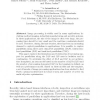Free Online Productivity Tools
i2Speak
i2Symbol
i2OCR
iTex2Img
iWeb2Print
iWeb2Shot
i2Type
iPdf2Split
iPdf2Merge
i2Bopomofo
i2Arabic
i2Style
i2Image
i2PDF
iLatex2Rtf
Sci2ools
103
click to vote
ACIVS
2005
Springer
2005
Springer
Designing Area and Performance Constrained SIMD/VLIW Image Processing Architectures
Abstract. Image processing is widely used in many applications, including medical imaging, industrial manufacturing and security systems. In these applications, the size of the image is often very large, the processing time should be very small and the real-time constraints should be met. Therefore, during the last decades, there has been an increasing demand to exploit parallelism in applications. It is possible to explore parallelism along three axes: data-level parallelism (DLP), instructionlevel parallelism (ILP) and task-level parallelism (TLP). This paper explores the limitations and bottlenecks of increasing support for parallelism along the DLP and ILP axes in isolation and in combination. To scrutinize the effect of DLP and ILP in our architecture (template), an area model based on the number of ALUs (ILP) and the number of processing elements (DLP) in the template is defined, as well as a performance model. Based on these models and the template, a set of kernels of image p...
ACIVS 2005 | Computer Vision | Data-level Parallelism | Image Processing | Instructionlevel Parallelism |
Related Content
| Added | 26 Jun 2010 |
| Updated | 26 Jun 2010 |
| Type | Conference |
| Year | 2005 |
| Where | ACIVS |
| Authors | Hamed Fatemi, Henk Corporaal, Twan Basten, Richard P. Kleihorst, Pieter P. Jonker |
Comments (0)

